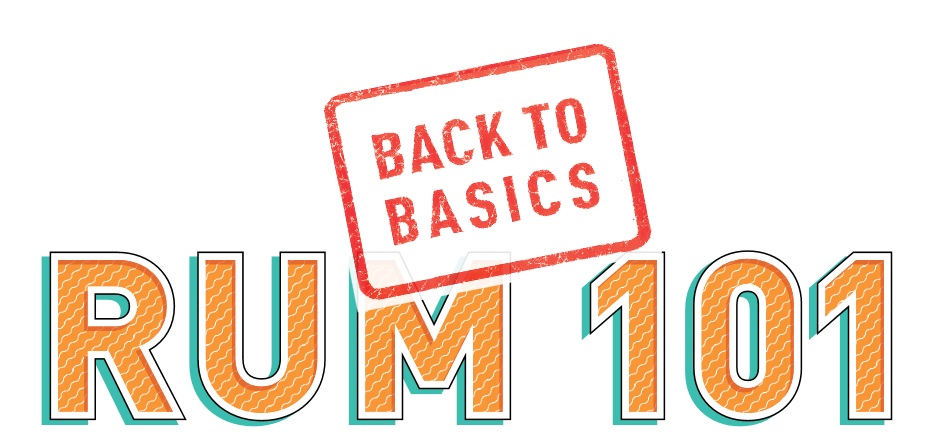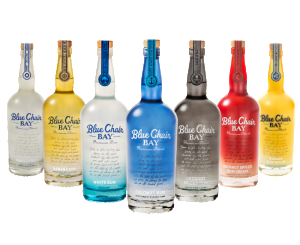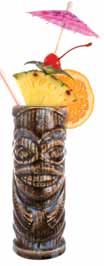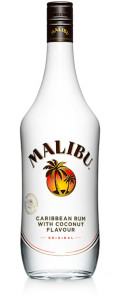
By Jeff Cioletti
 Everyone loves a good tropical drink—be it at a tiki bar, on a Caribbean cruise or at some island resort. Sweet and cold, yet refreshing. The real star of this lush liquid genre, is rum. Though it comes in many iterations, all rum can be traced back to sugarcane—so abundant in island climates. The song that island-hopping pirates sing isn’t “Yo-ho-ho and a bottle of gin,” after all.
Everyone loves a good tropical drink—be it at a tiki bar, on a Caribbean cruise or at some island resort. Sweet and cold, yet refreshing. The real star of this lush liquid genre, is rum. Though it comes in many iterations, all rum can be traced back to sugarcane—so abundant in island climates. The song that island-hopping pirates sing isn’t “Yo-ho-ho and a bottle of gin,” after all.
Perhaps befitting its relative lack of regulation, rum has long been a renegade spirit, from pirates of yore to rum-runners of Prohibition. Whether on high seas or through back doors, rum has remained an American favorite in many forms and formats. A sense of adventure is still palpable in many brands, by tattoo or barrel or cane or pirate map. From a simple base of sugar, a many-splendored spirit has evolved.
Where is it produced?
The short answer: everywhere. The general term, “rum” isn’t country-specific or a protected appellation. Just about any region or country with a spirits industry produces some variation on rum. However, the undisputed center remains in and around the Caribbean. Unfortunately, like anything rooted in the colonial era of the region, its origins are tied to the slave trade.
 What’s It Made From
What’s It Made From
- Most rum is distilled from molasses,a by-product of sugarcane processing. In the early 17th century, tslaves on Caribbean sugar plantations (most likely on Barbados) discovered that molasses can be fermented into alcohol and then distilled.
- Molasses is the result of a two-step boiling process. Refiners boil raw cane juice to concentrate and crystallize the sugar, producing a thick, sweet syrup, usually referred to as “first syrup” or mild molasses. It’s boiled again, producing “second” or “dark molasses.” A large percentage of rums are based on second molasses.
- If it’s boiled a third time, the resulting by-product is the much darker “blackstrap molasses,” from which some rums are also produced.
- In some countries—particularly the French West Indies where it’s called rhum agricole producers ferment and distill the pure sugarcane juice.
- Rum’s cousin, cachaça, a product unique to Brazil, also derives from unprocessed cane juice.
- The fermenting of raw sugarcane juice is a much older practice, having been made in Asia a millennium ago. In turn, distilling from pure cane juice retains many of the vegetal characteristics inherent in the plant.
Know your rum types?
Rums range from clear to dark and their depth of color often is region-specific (and not always natural). Spanish-speaking countries produce most of the lighter rums, while English-speaking tropical islands and territories are known as the source of most of the darker ones. As with whiskey and tequila, the length of the maturation period plays a key role in rum’s flavor.
- White silver rum: aged up to one year in oak barrels. Clear in color. Little flavor complexity; used primarily as a cocktail mixer.
- Gold amber rum: modest ageing in charred oak barrels. Amber color from barrel aging. Good bridge between light and dark rums; more flavor nuances (vanilla, caramel, etc.), thanks to the wood; still commonly used in cocktails.
- Dark rum: typically aged longer than gold rums, often several years; usually in charred oak casks. Deeper amber/brown in color. Generally a bit more flavor and aromatic complexity. Notes of cinnamon, brown sugar, deeper caramel and vanilla, other baking spices and even a bit of smoke.
- Spiced rum: aging varies widely, color is on the darker side, but not always through aging (caramel sometimes added for color). They get their flavor from the infusion of spices like cinnamon, allspice, nutmeg, cloves, etc.
- Rhum Agricole: three months minimum for “white,” longer for paille (straw) and ambré (amber); rhums aged 3 years or more are “vieux.” The preferred spirit of the French West Indies; “agricole” refers to the raw plant it’s distilled (sugarcane instead of molasses), giving it some distinct vegetal notes.
- Cream rum: aging is not a factor. It’s silky, opaque white in color. Technically liqueur, rum-based creams are lower in alcohol by volume and present as rich, creamy and sweet, with additional flavors often featured.
 Featured Brand: Blue Chair Bay Rum
Featured Brand: Blue Chair Bay Rum
Smooth and rich, rum creams (technically liqueurs) are another important branch of the rum tree, first emerging in the early 1980s and built on the success of whiskey cream cordials. With a lower proof and infused with natural flavor and a smack of sweetness, these creamy rum-based spirits work brilliantly in tropical cocktails.
Keeping It tropical
The tropical tilt is a particular strength for Blue Chair Bay, the line of rums developed by multi-platinum singer-songwriter Kenny Chesney. The brand’s island image is well tailored to Chesney’s “No Shoes Nation” fan base. Blue Chair offers seven rums, but the two cream expressions have been especially popular.
- Both have a base of Caribbean rum, plus real sugar and natural ingredients
- Banana Rum Cream shows ripe banana, vanilla, creamy caramel, baking spices and balanced sweetness
- Coconut Spiced Rum Cream blends toasted coconut aromatics with vanilla and warm island spices as well as cinnamon, nutmeg and clove
Mixing It Up
Rum creams’ lower alcohol content makes them ideal for lighter summer cocktails. Blue Chair Coconut Spiced Rum Cream’s signature drink is The Float, a blend of Spiced Rum Cream and root beer. The Riptide is a combination of Blue Chair Banana Rum Cream and coconut water.
Cocktail recipe: Riptide
- 2 oz. Blue Chair Bay Banana Rum Cream
- 4 oz. Coconut Water
- Pour ingredients over ice and stir. Garnish with a pineapple leaf if you’re in the mood to impress.
What Is Cachaça?
While technically part of the rum family, cachaça was officially recognized by the United States as a distinctive product of Brazil in 2013. Like rhum agricole, producers ferment pure cane juice,rather than sugarcane by-products, and then distill the fermented liquid. Cachaça benefits a great deal from the unique terroir of its home country. When cachaça is distilled close to a rainforest, it often picks up the flavors of the surrounding flora, including bananas.
Common Uses
- Mojito: Cuba’s most famous rum drink has also become a stateside favorite; it consists of white rum, lime juice, sugar and fresh mint, topped with sparkling water and served over ice.
- Daiquiri: The most popular member of the frozen family tends to be the Strawberry Daiquiri (rum, ice, sugar, strawberries, lemon juice, lime juice, all thrown in a blender).
- Piña colada: Celebrated in song, and mixed enthusiastically by lovers of all things tropical, this pineapple and coconut tandem remains a summer staple. Made like a daiquiri, in a blender.
- Dark ‘n’ stormy: Dark rum is the preferred base for this Bermudan-born cocktail, which continues to inspire spin-offs.Ginger beer, bitters and ice make up the rest of the recipe
- Cuba Libre: Essentially a Rum and Coke (with dark or light rum, and sometimes lime), this drink is said to have been invented in Havana around 1901 by patriots aiding Cuba during the Spanish-American War.
 What Are The Latest Rum Trends?
What Are The Latest Rum Trends?
- Upscale Leads the Way. As with many other spirits categories, the real growth is in the higher-end segments, though not quite as robust as in whiskey and some other categories. Last year, super-premium rum grew 2.9%, according to the Distilled Spirits Council; the overall category was down 1.5%.
- Cocktails Key? In the city where most beverage trends are born, Portland, Oregon, the Rum Club is a popular craft bar; one of the most popular drinks is the Rum Old Fashioned, which substitutes rum for bourbon or rye.
- Tiki Time! The resurgence of tiki bar culture is encouraging consumers to take a second look at the spirit, educating them on the differences among silver, dark and gold rumsand how they often complement and contrast one another when they’re layered in the same drinks.
- Fresh Sips. As the whiskey renaissance is starting to spill over into other segments, consumers are getting more savvy about barrel aging and “single-estate” rums. Many of the new products launching in the past five years have been geared toward sipping.
- Shot Heard Round the World? Meanwhile, with cinnamon-heat still firing on all cylinders, spicy-hot rum, designed for shots, has joined the bar scene. Only time will tell which types of usage will gain traction.
Did you know?
Rum’s pirate identity goes back centuries. Robert Louis Stevenson’sTreasure Island,published in 1883, includes the pirate song “Fifteen Men on the Dead Man’s Chest,” with the iconic line “Yo ho ho and a bottle of rum.”
Featured Brand: Sailor Jerry Rum
While rum in general is associated with the tropics, spiced rum in particular has come to be associated with adventures on the high seas, including the tattoo culture embraced by sailors. One sailor in particular, Norman Collins, pioneered techniques that literally transformed tattooing into an artform. Known as “Sailor Jerry,” his impact on the tattoo culture in the 20th century is now rivaled by the impact of his namesake rum on the spiced rum subcategory.
- Back in the day, sailors used to smooth out their high-proof rum ration with spices.
- Sailor Jerry Spiced Rum follows that same tradition, using natural spices and flavors—cinnamon, nutmeg, vanilla—all in a proprietary recipe (of course).
- The flavors need to be bold and rich to hold their own in the 92 proof (46% ABV) rum.
- Overall profile is bold yet smooth, balanced with a subdued sweetness and a hint of burnt toffee
Character Meets Versatility
The richness of natural spices in Sailor Jerry Spiced Rum means it can be sipped on its own or easily mixed. In this “High Honor” cocktail, which celebrates Sailor Jerry’s service in the U.S. Navy, the rum base supports a combo of sweet tea, blueberries and citrus.
Cocktail recipe: Sailor Jerry’s “High Honor”
- 2 oz Sailor Jerry Spiced Rum
- 1 oz Sweet Tea
- 12 muddled Blueberries
- Juice from half a Lemon
- Juice from half a Lime
- Splash Lemon-Lime Soda
Combine over ice in a shaker and shake vigorously; double strain over ice into signature Sailor Jerry Oil Can and top with a splash of lemon-lime soda. Garnish with a strawberry.
Tiki Drinks
There are hundreds of tiki drinks and many of those are proprietary creations at their respective bars. As a genre, tiki drinks are known for both exotic (and often multiple) ingredients and painstaking preparation steps. Some of the more universal classics include:
- Planter’s Punch (dark rum, orange, lemon and pineapple juices, grenadine, bitters)
- The Blue Hawaiian (rum, wblue curacao, crème de coconut, pineapple juice, maraschino garnish)
- The Zombie (light and dark rum, orange curacao, lemon, lime and orange juice; passion fruit puree, bitters, grenadine)
- The Mai Tai (gold, light and dark rum, orgeat, triple sec, dash of seltzer, slice of lime, maraschino garnish).
 Featured Brand: Malibu Rum
Featured Brand: Malibu Rum
Born in Barbados in 1983, Malibu includes the flavor of coconut, a taste profile that has resonated with rum drinkers the world over.
Malibu Essentials
- Based on Barbados rum, which is traditionally lighter and more delicate than other rums
- Cane is converted to cane juice and molasses, then distilled three times
- Malibu’s white rum base is blended with coconut flavors to give Malibu a subtly sweet refreshing coconut taste with a light finish
- Across the line, with ABV at 21% (42 proof), Malibu stands out as a light spirit that is extremely versatile
Power of Flavor
Malibu’s ability to extend into diverse directions speaks to the power of flavor in the rum category overall. In fact, Malibu represents 48% of the flavored rum category.* Line extensions include:
- 70 proof Malibu Black
- In addition to Coconut, a wide range of fruit flavors, including Malibu Pineapple, Malibu Mango, Malibu Passion Fruit, Malibu Tropical Banana and Malibu Island Melon
- Malibu ready-to-drink (RTD) cocktails, in both pouch and cans
Masterful Mixing
Light body and built-in coconut foundation make Malibu a natural for tropical cocktails.
Cocktail recipe: Malibu Pineapple
- 1 part Malibu Original
- 2 parts Pineapple Juice
- Pineapple Garnish
Fill a chilled highball glass with ice cubes. Add Malibu and top up with pineapple juice. Garnish with a pineapple wedge.
Share this link or read it via PDF.




